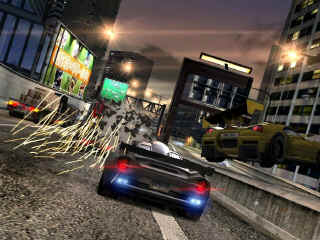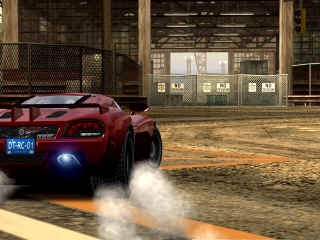 One tweak is all it
took to radically changed the Burnout series. The latest addition in Burnout
Revenge, same direction traffic checking, is the wildest transition into new
territory for the series since the Crash mode was created in Burnout 2. It's
something that may not sit well for those accustomed to dodging every piece of extra
traffic, but it becomes a new experience, a completely new game.
One tweak is all it
took to radically changed the Burnout series. The latest addition in Burnout
Revenge, same direction traffic checking, is the wildest transition into new
territory for the series since the Crash mode was created in Burnout 2. It's
something that may not sit well for those accustomed to dodging every piece of extra
traffic, but it becomes a new experience, a completely new game. The graphics engine is the obvious change before the new gameplay feature set kicks in, and this is probably the closest we'll come to next-generation graphics on this current set of consoles. Immense detail is packed into the most insignificant building, and it makes the sense of speed, already considered flawless in Burnout 3, even more intense. It wouldn't be surprising to hear stories of people complaining about motion sickness. Burnout Revenge is that incredible to watch, let alone play.
Well known, the various race types the series has made a name for itself are all here, now with the Traffic Attack as well. Don't expect much of anything to change on the surface level. The new course design and gameplay mechanics are what makes this fresh, and the sheer number of changes almost makes this feel like a game from a different developer.
 It's the same
company though, so Criterion with their detailed physics and crash modeling, have come
back with some unique features to render the game almost unrecognizable. On the tracks,
the new traffic checking is a controversial switch for fans, seen briefly in the otherwise
awful Batman Begins
earlier this year. Instead of crashing into traffic headed into the same direction, you
now slam into it, pushing it away. You'll learn to use this quickly in Traffic Attack, a
wild, sometimes overblown mode dedicated solely to taking out as many vehicles as possible
using this new gameplay change.
It's the same
company though, so Criterion with their detailed physics and crash modeling, have come
back with some unique features to render the game almost unrecognizable. On the tracks,
the new traffic checking is a controversial switch for fans, seen briefly in the otherwise
awful Batman Begins
earlier this year. Instead of crashing into traffic headed into the same direction, you
now slam into it, pushing it away. You'll learn to use this quickly in Traffic Attack, a
wild, sometimes overblown mode dedicated solely to taking out as many vehicles as possible
using this new gameplay change.Now those non-racing vehicles become deadly projectiles. It's odd to imagine a racing game, arcade style or not, on the same level as a classic space shooter, yet that's close to what this series has become with Burnout Revenge. You'll still need to move out of the way of larger vehicles and opposite traffic flow, but now the ability to wipe out multiple opponents without touching them by bashing a car in their direction opens the game to all new strategies. They become deadly projectiles and an offensive weapon.
If you've become accustomed to the series on a track design level, you're in for a shock. Resembling Midway's Rush series, tracks are now built around shortcuts, necessary for everything other than the also revamped crash mode. Instead of leaving the task of finding these outlets to the player, most are highlighted by lights, making them easier to pick out in the rapidly passing backdrops. Generally, they work both ways too, so those reversed tracks always feel like new.
 Crash mode returns on
those same courses, and as is the norm for this new edition, completely redesigned. Gone
are the aggravating and over-complicated power-ups from last year's game. An odd new
feature, each crash junction begins with a meter which requires timed button presses to
set speed from the starting line. This is not a golf game, and the usefulness of this
feature is negligible. Most of the sections now have multiple plans of attack, ramps, and
other various hazards.
Crash mode returns on
those same courses, and as is the norm for this new edition, completely redesigned. Gone
are the aggravating and over-complicated power-ups from last year's game. An odd new
feature, each crash junction begins with a meter which requires timed button presses to
set speed from the starting line. This is not a golf game, and the usefulness of this
feature is negligible. Most of the sections now have multiple plans of attack, ramps, and
other various hazards. Traffic checking plays a role a role here like it does everywhere else, allowing you to earn cash before the pile-up even begins. All of that shows Criterion is set on providing new experiences, and in the end, it's just too convoluted (like the menu system). The crash junctions were once the centerpieces, and they've taken away the visceral simplicity the series was built upon. They sit behind the Burning Laps and Road Rage modes, and that's disappointing. There's nothing wrong with offering 25 same-looking sections with four lanes of traffic and letting people smash into the center. They seem to have forgotten the appeal there.
Being able to look back on the series is the easiest way to determine where this entry falls. It arguably does as much right as Burnout 3, but the controversial change to traffic checking could very well be a sign they're out of ideas. Its inclusion, like many over the short lifespan of the series so far, is obviously to keep this fresh regardless of how annual a new version is released. Burnout Revenge is memorable, but only to those who can embrace the changes that rip the heart right out of their favorite series, only to replace it with something that turns it into something else entirely.